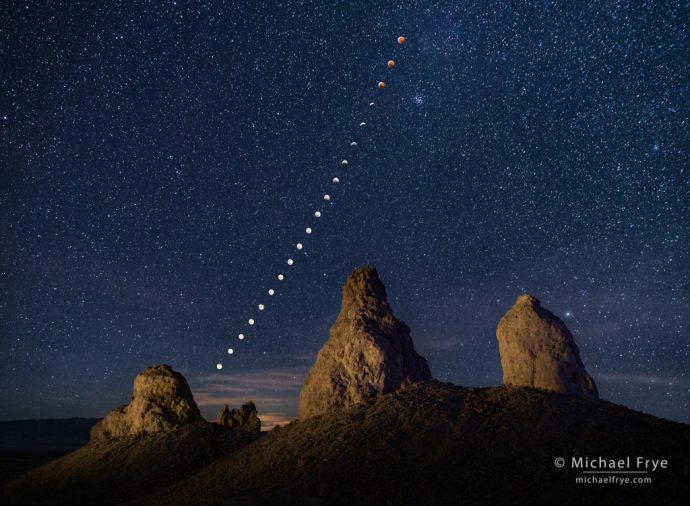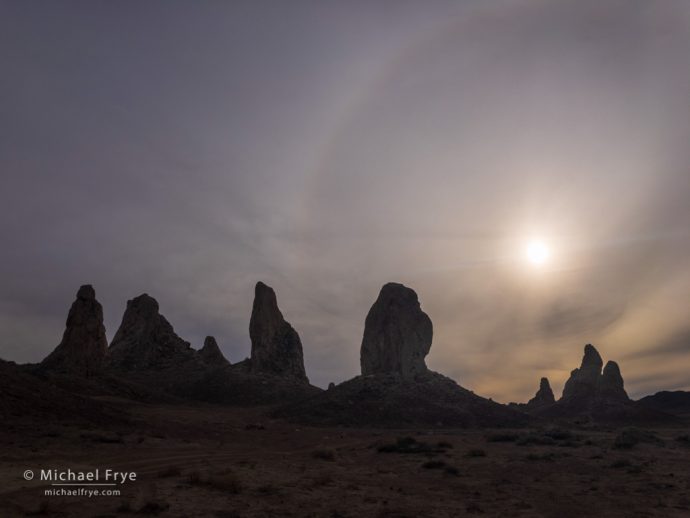The weather forecasts prior to last Sunday’s lunar eclipse showed lots of clouds over the western U.S. Lots of clouds. On Thursday before the eclipse it looked like we might possibly find clear skies in southern Arizona, or around Death Valley, but the chances for either location looked slim.
By Saturday it appeared that southern Arizona would probably be covered in clouds at eclipse time. Yet computer models for the evening of the eclipse kept showing a small slot of clear sky extending from about Lancaster, California (in the desert north of Los Angeles) northeast through the Trona Pinnacles, Death Valley, and continuing into Nevada and Utah. I couldn’t think of anything in Nevada to use as a foreground, but Death Valley or the Trona Pinnacles could certainly work.
Claudia and I headed in that direction, and spent Saturday night in Independence, on the eastern side of the Sierra near Lone Pine. After photographing sunrise at the Alabama Hills the next morning I looked at the weather forecasts one more time, and had to make a decision. In the end I opted for the Trona Pinnacles, as there appeared to be a slightly higher chance of clouds in Death Valley, and good foregrounds abound at Trona.
The weather didn’t look very promising that afternoon. The wind was picking up, and as I scouted for suitable locations among the pinnacles the skies were covered with high clouds:
But I could see blue sky off to the north, moving our way. Some lingering clouds created a nice sunset, and by the time I started my eclipse sequence we could see only a few strands of high clouds overhead.
I had found a spot where I could look east, toward where the eclipsed moon would be, with three nicely-spaced pinnacles in the foreground. Somehow my daytime calculations about the position of the moon were a little off, but it was easy to adjust my camera position slightly in order to put the rising moon between the first and second pinnacles.
I made my first exposure for the moon at 5:45 p.m., and continued capturing images of the moon every ten minutes as it rose high above the pinnacles. I kept this sequence going until 8:55, when the moon was totally eclipsed. The wind blew pretty hard the whole time, but luckily my camera position was somewhat sheltered by another pinnacle, so I stayed reasonably warm and didn’t have to worry about my tripod blowing over.
After completing the moon sequence I made some exposures for the stars, and finally, with Claudia’s help, light-painted the pinnacles. All 23 frames – 20 for the moons, one for the stars, and two light-painting images – were combined in Photoshop using the Lighten blending mode. And although this is obviously a composite, I never changed lenses or moved the camera during the sequence in an attempt to make the moons larger, or create a juxtaposition between the moon and pinnacles that didn’t really exist.
Here’s a video showing a satellite view of the clouds over the western U.S. during the eclipse last Sunday. The mouse cursor shows our approximate location in the Trona Pinnacles. The time frame shown in these satellite images extends from 3:00 p.m. to 9:00 p.m. Pacific Time:
(If you can’t view the video, click here.)
As you can see, the skies cleared over Trona during the exact window of time required to photograph the eclipse sequence. The large band of high clouds that covered the sky that afternoon glided off to the southeast toward Arizona, while another batch of clouds moving in from the northwest didn’t reach us until after totality. We could see those approaching clouds as we drove away from the Pinnacles and headed toward Lone Pine.
Thin clouds made the moon slightly hazy in a couple of the early frames of the sequence, but you can hardly tell in the final image. In short, I was really, really lucky that I was able to capture this image.
More importantly, Claudia and I got to view the eclipse. I’ve seen about half a dozen total lunar eclipses now, and each time is a special experience. At first it’s just a bright, moonlit night. Then the moon dims slightly. Then it dims a little more. Then it gets really dark, and thousands of stars pop out. Where earlier it was easy to walk around with just the moonlight for illumination, it’s suddenly pitch dark and you have to fish out your headlamp. And last Sunday the other-worldly, lunar landscape of the Trona Pinnacles added just the right mood to the occasion.
Despite the cold wind, we really enjoyed this eclipse. We won’t get to see another total lunar eclipse until May of 2021, so I’ll have to savor the memories of this one for awhile.
— Michael Frye
Related Posts: Sunset at the Trona Pinnacles; Photographing the Lunar Eclipse January 20th and 21st
Michael Frye is a professional photographer specializing in landscapes and nature. He is the author or principal photographer of The Photographer’s Guide to Yosemite, Yosemite Meditations, Yosemite Meditations for Women, Yosemite Meditations for Adventurers, and Digital Landscape Photography: In the Footsteps of Ansel Adams and the Great Masters. He has also written three eBooks: Light & Land: Landscapes in the Digital Darkroom, Exposure for Outdoor Photography, and Landscapes in Lightroom: The Essential Step-by-Step Guide. Michael has written numerous magazine articles on the art and technique of photography, and his images have been published in over thirty countries around the world. Michael has lived either in or near Yosemite National Park since 1983, currently residing just outside the park in Mariposa, California.











Hi Michael, I love the image. We had clear skies in Minneapolis for the lunar eclipse, but I opted not to try a sequence like your’s because I didn’t think I could get it in one frame. By the time the total eclipse occurred, the moon was very high, so I did a combination of five images in photoshop and one where I moved the total eclipse moon over the Minneapolis skyline. I like the skyline image, but feel somewhat bad that it is not a real image, but a photoshopped image. If you would like to see the images, they are at https://www.mikenadreauphotography.com/.
I’m curious as to the lens you used for your sequence image. I would guess in the 16-20mm range.
Thanks for all you do on your blog, I’ve followed it for years and always learn something.
Thanks Don. I’m glad you had clear skies, but night photography in Minneapolis in winter… brr! I don’t see anything wrong with creating a Photoshop composite as long as you’re up front about it, which you were. I used a 20mm lens for my sequence.
Michael, as usual a beautiful image and informative narrative. Could you share the radar/weather forecast that you use? Is the radar real time? I was at Amboy, CA and was undone by the cloud cover. Thank you.
Thanks Hadley. Radar doesn’t help with clouds – you need satellite imagery. I mostly use the NWS websites for forecasts and satellite images. There’s an app called Upweather – Beautiful Weather that shows “future” clouds. The Windy.com app and website can also do that.
Thank you, Michael. Much appreciated.
Very well planned and executed, Michael. This is probably my favorite eclipse sequence of yours.
Here in Texas, the moon was too high on the sky and there is not much foreground anyway, so I just enjoyed the view from my balcony. It was a great experience though.
Thanks Gabor. Unfortunately, yes, the eclipsed moon was high in the sky further east. Glad you enjoyed the show!
Very nice effort Michael. I had similar anxiety about the skies. I also considered Death Valley, but I ended up in central Nevada racing away from the drenching rain and thick clouds. Three and a half hours later the skies cleared and I was able to see the full eclipse. It was cold and extremely windy. I am always thrilled to see an eclipse and this was definitely worth it. We had to drive through snow blowing sideways and more rain, but 200 miles later we had returned home safely. I can’t wait for May 2021 at 4 am!
Sounds like quite an adventure Andrew! I’m glad you got to see the eclipse after all that.
Another excellent and beautiful lunar eclipse image Michael. Thanks for the backstory about your planning, such an important part of the process. The final composite image is outstanding. Your photography mastery and poetic artistry shines in this image.
Thanks so much Richard! Planning is pretty vital for events like this, but that means having a Plan B and maybe a Plan C, in case the weather doesn’t cooperate.
Hi Michael,
I really like the shot and hearing how you created it.
I wanted to try my hand at a sequence, but we literally had 10 minutes of clear skies between clouds and rain. I had looked for clear options around us, and they didn’t exist for a couple hundred miles.
So, I stayed home and kept my eye on it ready to go and quickly went out and tried some single shot compositions with focus stacking some foreground objects.
Oh well, sorry you weren’t able to see much of the eclipse, that’s how it goes I guess. At least you got to photograph a little bit of the eclipse.